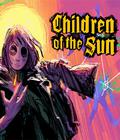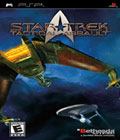Genre: Real-Time Strategy
Publisher: Bethesda Softworks
Developer: Quicksilver Software
Release Date: October 26, 2006
We've all heard of the voyages of the Starship Enterprise. From the classic Captain Kirk to the modern Captain Archer, countless people have followed the adventures of the Federation and its crews through their continuing quest to explore the final frontier. Star Trek: Tactical Assault doesn't focus on any of these illustrious crews, instead introducing a pair of new captains, the Federation Captain Renolds and the Klingon Commander Kadir. Set during the time of the original "Star Trek" series, these two captains must work to preserve the tenuous peace treat between their peoples, despite the actions of the Romulan and traitors within their own factions.
Gameplay in Star Trek: Tactical Assault takes place entirely in your ship. There are no Away Teams in this trek; the entire game focuses on whichever ship you happen to be controlling. All the action takes place on the top screen, while the bottom screen is dedicated to a status readout of your ship. Your ship can be controlled either through the touch-screen or through the DS' face buttons. However, the touch-screen control is significantly more clumsy and slow when compared to using the buttons. Turning and moving the ship is done via "bars," which are fairly inaccurate and difficult to control. To make matters worse, players must switch view screens to fire overcharged weapons, activate the shield recharge or check the current status of their weapons. It's a lot of switching back and forth for something that should be accessed with the press of a button.
A great majority of Tactical Assault revolves around ship-to-ship combat. While diplomacy is possible with some foes, it always leads you into battle with a different set of enemies. Combat in Tactical Assault is a bit different from most space combat series in that you control a capital ship instead of a starfighter. Thus, combat is less about dodging and more about managing your defenses while striking an enemy's weak point. Ships are slow and not very agile, so dodging attacks is nearly impossible. All ships have a ring of shields around them; striking a section of the shield slowly weakens it, and enough damage can bring down that section, allowing an attack on the hull.
All ships come equipped with either phasers (for the Federation) or disruptors (for the Klingons) and torpedoes. The phasers are fast-firing and quick to recharge, but not very powerful, while torpedoes are slow and powerful. The weapons are placed on various points along the ship's hull, and they can only fire if pointed toward the enemy, so maneuvering your ship for both offense and defense is the key to battle. While combat is fun at first, it quickly begins to grow repetitive and tedious, especially when your ships become so powerful that combat ceases to be a challenge. While it's on, it's extremely on, but that starts to fail midway through the two campaigns.
Of course, a Captain is nothing without his crew. The better your complete objectives, the more points you get; an "Excellent" ranking grants you two points, and "Good" only garners one point. As you progress through the storyline, your success grants you Crew Upgrade points, which can be spent during intermission to upgrade your crew members. Upgrading the Captain lowers damage and increases the amount of excess energy you can spend, the Executive Officer decreases energy cost, the Helmsman improves the ship's speed and agility, the Tactical Officer improves weapon power and accuracy and Engineering improves the recharge rate of weapons and emergency energy.
While interesting, this system has two flaws: Many of the upgrades are significantly better than others, and while you can technically get through the game with any combination of abilities, it becomes incredibly difficult when you don't focus on a select few. This problem is compounded by how a player earns points. To earn two points, a player must successfully complete every objective, including any optional ones. Many of these are well-hidden or incredibly difficult to complete without a proper set of upgrades, and thus the player earns fewer points. Consequently, the next objective is harder because they have fewer upgrades, and so they get fewer points… While this isn't a problem once you know the objective, it can be frustrating to lose a point simply because you warped to the wrong location.
Each ship performs differently. While every ship has the same controls, the tactics required to succeed in battle vary from ship to ship. Federation Star Cruisers can't attack opponents in the same way as a Klingon Bird of Prey, and Frigates can't fight in the same manner as a Dreadnought. Each ship has a different phaser and torpedo placement, in addition to numerous levels of shields in different locations. One of the biggest variations in a ship is if it has shield regeneration or a cloaking device. Federation ships come equipped with a Shield Recharger, which allows the ship to drain excess power to keep shields running at full capacity, thus giving them a significant boost to defense in straight-up firefights. Klingon and Romulan ships have cloaking devices that turn them invisible, although there is a brief window during the cloaking process when shields are down and the ship is vulnerable to fire.
Aside from the single-player campaign, Star Trek: Tactical Assault also offers a number of free play modes. Skirmish allows players to use any ship they've unlocked in the campaign mode in a free-for-all battle against customizable enemies in various battlefields – great for those who just want to enjoy the battles. Tactical Assault also offers a multiplayer option, featuring Skirmish mode as well as Battlefest, which allows players to take increasingly powerful ships against one another until one wins. While these options add a bit of replay value to the game, they're nowhere near as enjoyable as the campaign mode, and pointless combat quickly grows tedious, even with new ships.
One of the biggest problems with Star Trek: Tactical Assault is its graphics. The Nintendo DS can perform surprisingly good 3D graphics at times, but it just doesn't work for this title. The ships and blocks and difficult to distinguish from one another, and unless you're directly in front of a ship, it is very difficult to tell what direction it is facing. Most of the time, they look like indistinct green or grey smudges, which can be a massive problem late in the game, when knowing a ship's weak points means the difference between life and death. A worse problem occurs with starbases and planets: Telling where empty space ends and the starbase begins is a matter of lucky guessing, and a single wrong turn can have a player's ship instantly destroyed, despite seeming to be a safe distance away from any celestial object. The game features hand-drawn character art for all of the characters, but it is simplistic and frankly a bit unattractive. Overall, Tactical Assault is not one of the DS' prettier offerings.
The audio aspect is, thankfully, quite a bit stronger than the visuals. The soundtrack mixes between soft calming music when traveling and tense beats when in the middle of battles. The phaser and torpedo sounds match their in-show counterparts quite well, and the sound of an exploding enemy ship gives a deep sense of satisfaction. There isn't a great variation in the music unfortunately, and you'll hear the same tracks over and over. It's not a deal breaker, but some more variety would have been nice.
In the end, Star Trek: Tactical Assault isn't great. It's slow-paced, repetitive and a bit unbalanced, the lack of variety in combat really hurts the game, and the lackluster graphics really can grow frustrating at times. The two campaigns are fun, but they're a bit too easy to give the title any replay value. For Trek fans looking for some on-the-go fun, this is a good choice. For those who can't tell a Tribble from a tire iron, I'll say this: I'm not much of a Star Trek fan, and I enjoyed Tactical Assault. It's far from perfect and requires a lot of patience, and it isn't for everyone, but if you're willing to overlook its glaring flaws and give it a shot, you just might have some fun, but don't make it your first choice.
Score: 6.5/10
More articles about Star Trek: Tactical Assault











 Star Trek: Tactical Assault features real-time spaceship combat from the universe of the original Star Trek series. With a wide array of authentic Star Trek races, ships, and weaponry, you can engage in single-player battle through either the Federation or Klingon campaigns or in head-to-head wireless multiplayer combat.
Star Trek: Tactical Assault features real-time spaceship combat from the universe of the original Star Trek series. With a wide array of authentic Star Trek races, ships, and weaponry, you can engage in single-player battle through either the Federation or Klingon campaigns or in head-to-head wireless multiplayer combat.
































